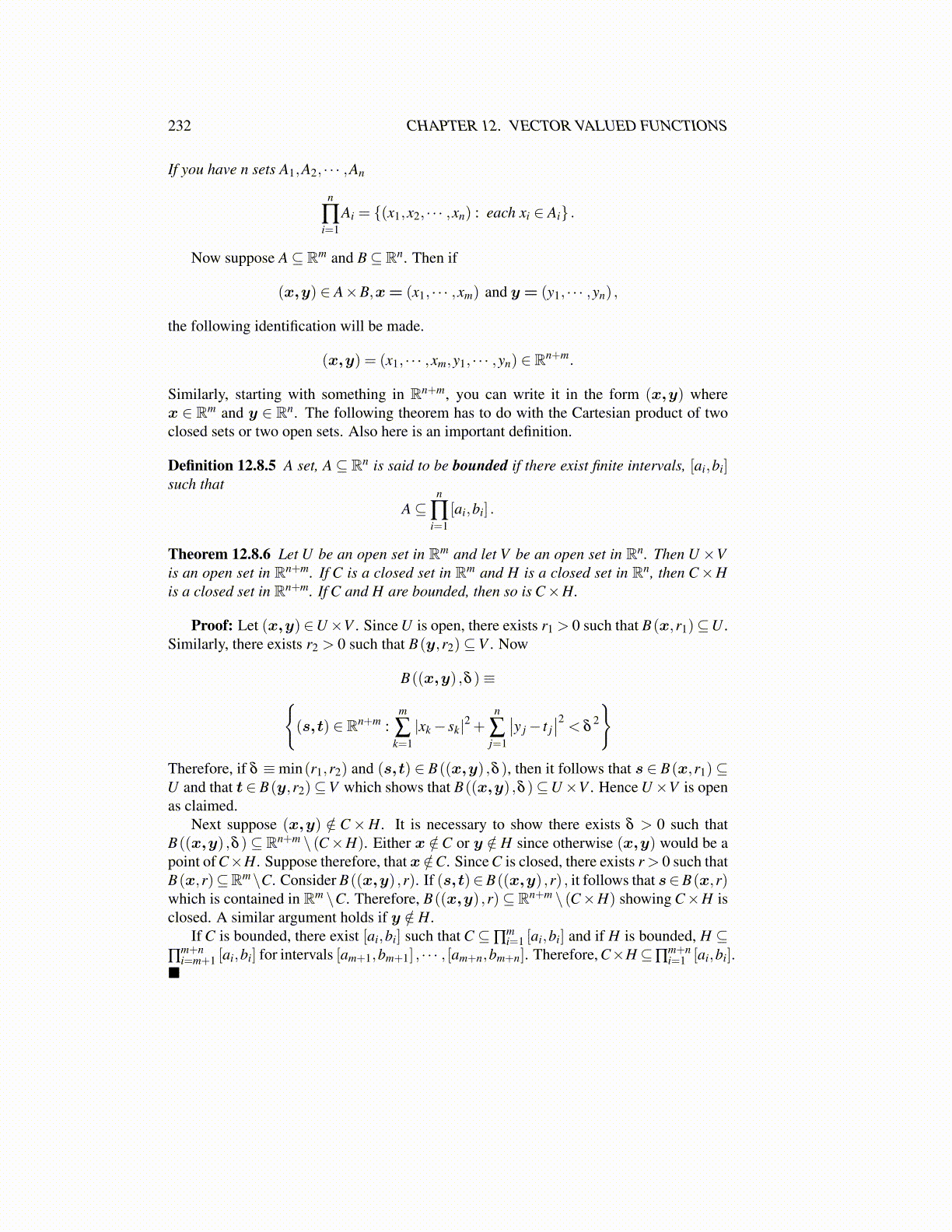
232 CHAPTER 12. VECTOR VALUED FUNCTIONS
If you have n sets A1,A2, · · · ,An
n
∏i=1
Ai = {(x1,x2, · · · ,xn) : each xi ∈ Ai} .
Now suppose A⊆ Rm and B⊆ Rn. Then if
(x,y) ∈ A×B,x= (x1, · · · ,xm) and y = (y1, · · · ,yn) ,
the following identification will be made.
(x,y) = (x1, · · · ,xm,y1, · · · ,yn) ∈ Rn+m.
Similarly, starting with something in Rn+m, you can write it in the form (x,y) wherex ∈ Rm and y ∈ Rn. The following theorem has to do with the Cartesian product of twoclosed sets or two open sets. Also here is an important definition.
Definition 12.8.5 A set, A⊆ Rn is said to be bounded if there exist finite intervals, [ai,bi]such that
A⊆n
∏i=1
[ai,bi] .
Theorem 12.8.6 Let U be an open set in Rm and let V be an open set in Rn. Then U ×Vis an open set in Rn+m. If C is a closed set in Rm and H is a closed set in Rn, then C×His a closed set in Rn+m. If C and H are bounded, then so is C×H.
Proof: Let (x,y)∈U×V . Since U is open, there exists r1 > 0 such that B(x,r1)⊆U .Similarly, there exists r2 > 0 such that B(y,r2)⊆V . Now
B((x,y) ,δ )≡{(s,t) ∈ Rn+m :
m
∑k=1|xk− sk|2 +
n
∑j=1
∣∣y j− t j∣∣2 < δ
2
}Therefore, if δ ≡min(r1,r2) and (s,t) ∈ B((x,y) ,δ ), then it follows that s ∈ B(x,r1)⊆U and that t ∈ B(y,r2)⊆V which shows that B((x,y) ,δ )⊆U×V . Hence U×V is openas claimed.
Next suppose (x,y) /∈ C×H. It is necessary to show there exists δ > 0 such thatB((x,y) ,δ )⊆ Rn+m \ (C×H). Either x /∈C or y /∈ H since otherwise (x,y) would be apoint of C×H. Suppose therefore, that x /∈C. Since C is closed, there exists r > 0 such thatB(x,r)⊆Rm\C. Consider B((x,y) ,r). If (s,t)∈B((x,y) ,r) , it follows that s∈B(x,r)which is contained in Rm \C. Therefore, B((x,y) ,r)⊆ Rn+m \ (C×H) showing C×H isclosed. A similar argument holds if y /∈ H.
If C is bounded, there exist [ai,bi] such that C ⊆∏mi=1 [ai,bi] and if H is bounded, H ⊆
∏m+ni=m+1 [ai,bi] for intervals [am+1,bm+1] , · · · , [am+n,bm+n]. Therefore, C×H ⊆∏
m+ni=1 [ai,bi].
■